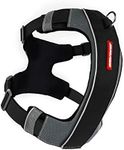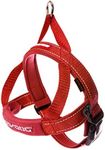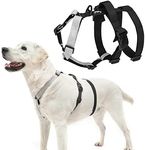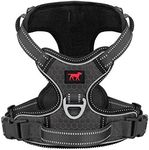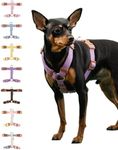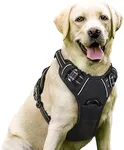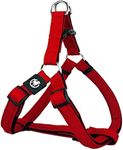Buying Guide for the Best Chew Proof Dog Harness
Choosing a chew-proof dog harness is important if your dog tends to chew through regular harnesses, which can be both costly and unsafe. The right harness should be comfortable for your dog, durable enough to withstand chewing, and easy for you to use. When shopping, focus on the materials, construction, fit, and safety features to ensure you get a harness that meets your dog's needs and your peace of mind.MaterialThe material of a chew-proof dog harness is crucial because it determines how resistant the harness will be to your dog's chewing. Common materials include nylon, polyester, and metal, but for chew-proof options, look for harnesses made with reinforced nylon, ballistic materials, or even metal components. Softer materials are more comfortable but less durable, while tougher materials can withstand more chewing but may be less flexible. If your dog is a light chewer, a reinforced nylon harness may suffice, but for heavy chewers, opt for harnesses with metal or extremely tough synthetic fibers.
Stitching and ConstructionThe way a harness is put together affects its durability. Double or triple stitching, reinforced seams, and minimal exposed edges make it harder for dogs to find a weak spot to chew. Harnesses with poor stitching or lots of loose ends are easier for dogs to destroy. If your dog is persistent, look for harnesses with heavy-duty stitching and as few exposed seams as possible.
HardwareHardware refers to the buckles, rings, and adjustment points on the harness. Metal hardware is generally more chew-resistant than plastic, which can crack or break under pressure. If your dog targets buckles or rings, choose a harness with metal hardware, especially in high-stress areas like the leash attachment point.
Fit and AdjustabilityA well-fitting harness is less likely to be chewed because it sits snugly against your dog's body, making it harder for them to reach. Adjustable straps allow you to customize the fit, which is important for both comfort and security. If your dog is an escape artist or tends to wriggle out of harnesses, look for options with multiple adjustment points and a snug, secure fit.
Padding and ComfortPadding adds comfort, especially for dogs that wear their harness for long periods. However, too much padding can give your dog something to chew on. Look for harnesses with minimal but effective padding, or padding that is covered with tough, chew-resistant fabric. If your dog is sensitive or has thin fur, some padding is important, but balance comfort with durability.
Design and CoverageThe design of the harness can influence how easy it is for your dog to chew. Harnesses with wide coverage or extra straps may give your dog more opportunities to reach and chew. Simpler designs with fewer loose ends and less excess material are harder for dogs to get their mouths on. If your dog is very determined, choose a harness with a streamlined design and minimal excess material.


